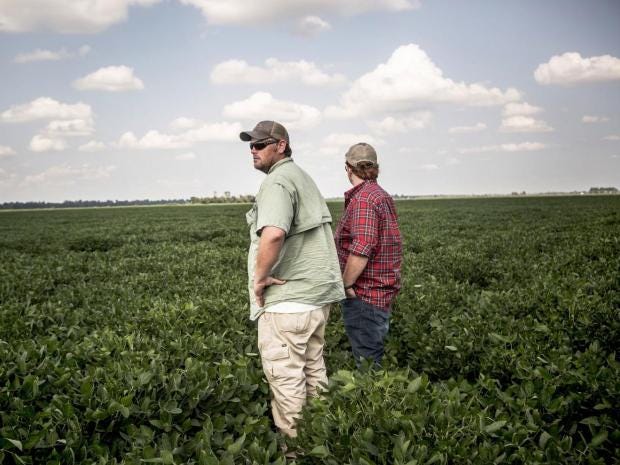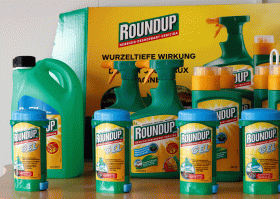'Miracle' weed killer that was supposed to save farms is killing them instead
Controversial herbicide dicamba found to poison crops as well as pigweed chemical was intended to root out
| 920 |
Click to follow
The Independent US
The Independent US

Clay Mayes slams on the brakes of his Chevy Silverado and jumps out with the engine running, yelling at a dogwood by the side of the dirt road as if it said something insulting.
Its leaves curl downward and in on themselves like tiny, broken umbrellas. It's the telltale mark of inadvertent exposure to a controversial herbicide called dicamba.
“This is crazy. Crazy!” shouts Mayes, a farm manager, gesticulating toward the shrivelled canopy off Highway 61. “I just think if this keeps going on...”
“Everything'll be dead,” says Brian Smith, his passenger.
The damage here in northeast Arkansas and across the Midwest - sickly soybeans, trees and other crops - has become emblematic of a deepening crisis in American agriculture.
Farmers are locked in an arms race between ever-stronger weeds and ever-stronger weed killers.
The dicamba system, approved for use for the first time this spring, was supposed to break the cycle and guarantee weed control in soybeans and cotton. The herbicide - used in combination with a genetically modified dicamba-resistant soybean - promises better control of unwanted plants such as pigweed, which has become resistant to common weed killers.
The problem, farmers and weed scientists say, is that dicamba has drifted from the fields where it was sprayed, damaging millions of acres of unprotected soybeans and other crops in what some are calling a man-made disaster. Critics contend that the herbicide was approved by federal officials without enough data, particularly on the critical question of whether it could drift off target.
Government officials and manufacturers Monsanto and BASF deny the charge, saying the system had worked as Congress designed it.
The backlash against dicamba has spurred lawsuits, state and federal investigations, and one argument that ended in a farmer's shooting death and related murder charges.
“This should be a wake-up call,” said David Mortensen, a weed scientist at Pennsylvania State University.
Herbicide-resistant weeds are thought to cost US agriculture millions of dollars per year in lost crops.
After the Environmental Protection Agency approved the updated formulation of the herbicide for use this spring and summer, farmers across the country planted more than 20 million acres of dicamba-resistant soybeans, according to Monsanto.
But as dicamba use has increased, so too have reports that it “volatilises,” or re-vaporises and travels to other fields. That harms nearby trees, such as the dogwood outside of Blytheville, as well as nonresistant soybeans, fruits and vegetables, and plants used as habitats by bees and other pollinators.
According to one 2004 assessment, dicamba is 75 to 400 times more dangerous to off-target plants than the common weed killer glyphosate, even at very low doses. It is particularly toxic to soybeans - the very crop it was designed to protect - that haven't been modified for resistance.
Kevin Bradley, a University of Missouri researcher, estimates that more than 3.1 million acres of soybeans have been damaged by dicamba in at least 16 states, including major producers such as Iowa, Illinois and Minnesota. That figure is probably low, according to researchers, and it represents almost 4 percent of all US soybean acres.
“It's really hard to get a handle on how widespread the damage is,” said Bob Hartzler, a professor of agronomy at Iowa State. “But I've come to the conclusion that [dicamba] is not manageable.”
The dicamba crisis comes on top of lower-than-forecast soybean prices and 14 straight quarters of declining farm income. The pressures on farmers are intense.
One Arkansas man is facing murder charges after he shot a farmer who had come to confront him about dicamba drift, according to law enforcement officials.
Thirty minutes down the road, Arkansas farmer Wally Smith is unsure how much more he can take.
Smith's farm employs five people - including Wally's son, Hughes, his nephew, Brian, and the farm manager, Mayes. None of the men are quite sure what else they'd do for work in this corner of Mississippi County.
Dicamba has hit the Blytheville - pronounced “Bly-vul” - region hard. For miles in any direction out of town, the soybeans that stretch from the road to the distant tree line are curled and stunted. A nearby organic farm suspended its summer sales after finding dicamba contamination in its produce.
At the Smiths' farm, several thousand acres of soybeans are growing too slowly because of dicamba, representing losses on a $2 million investment.
“This is a fact,” the elder Smith said. “If the yield goes down, we'll be out of business.”
The new formulations of dicamba were approved on the promise that they were less risky and volatile than earlier versions.
Critics say that the approval process proceeded without adequate data and under enormous pressure from state agriculture departments, industry groups and farmers' associations. Those groups argued that farmers desperately needed the new herbicide to control glyphosate-resistant weeds, which can take over fields and deprive soybeans of sunlight and nutrients.
Such weeds have grown stronger and more numerous over the past 20 years - a result of herbicide overuse. By spraying so much glyphosate, farmers inadvertently caused weeds to evolve resistant traits more quickly.
The new dicamba formulations were supposed to attack these resistant weeds without floating to other fields.
But during a July 29 call with EPA officials, a dozen state weed scientists expressed unanimous concern that dicamba is more volatile than manufacturers have indicated, according to several scientists on the call. Field tests by researchers at the Universities of Missouri, Tennessee and Arkansas have since found that the new dicamba herbicides can volatilise and float to other fields as long as 72 hours after application.
Regulators did not have access to much of this data. Although Monsanto and BASF submitted hundreds of studies to the EPA, only a handful of reports considered volatility in a real-world field setting, as opposed to a greenhouse or a lab, according to regulatory filings. Under EPA rules, manufacturers are responsible for funding and conducting the safety tests the agency uses to evaluate products.
READ MORE
- World’s soils have ‘lost 133 billion tonnes of carbon' in 12,000 years
- Democrats in fight to block Trump agriculture nominee
- US Agriculture agency told to 'avoid' using the term climate change
- ‘Agricultural sector will face major disruption without EU labour'
- Trump's Secretary of Agriculture once held a prayer vigil for rain
And although pesticide-makers often supply new products to university researchers to conduct field tests in varied environments, Monsanto acknowledged it did not allow that testing on its commercialised dicamba because it did not want to delay registration, and scientists said BASF limited it.
Frustrated scientists say that allowed chemical companies to cherry-pick the data available to regulators.
“Monsanto in particular did very little volatility field work,” said Jason Norsworthy, an agronomy professor at the University of Arkansas who was denied access to test the volatility of Monsanto's product.
The EPA and chemical manufacturers deny that there was anything amiss in the dicamba approval process.
“The applicant for registration is required to submit the required data to support registration,” the agency said in a statement. “Congress placed this obligation on the pesticide manufacturer rather than requiring others to develop and fund such data development.”
Manufacturers says that volatility is not to blame. In a statement, BASF spokeswoman Odessa Patricia Hines said the company brought its dicamba product to market “after years of research, farm trials and reviews by universities and regulatory authorities.”
Scott Partridge, Monsanto's vice president of global strategy, thinks some farmers have illegally sprayed older, more volatile dicamba formulations or used the herbicide with the wrong equipment.
The company, which invested $1 billion in dicamba production plants last year, has deployed a fleet of agronomists and climate scientists to figure out what went wrong.
“We're visiting every grower and every field,” Partridge said. “If there are improvements that can be made to this product, we're going to do it.”
Regulators in the most-affected states are also taking action. In July, Arkansas banned spraying for the remainder of the season and raised the penalties on illegal applications.
Missouri and Tennessee have tightened their rules on dicamba use, while nearly a dozen states have complained to the EPA.
The agency signalled in early August that it might consider taking the new dicamba herbicides off the market, according to several scientists who spoke to regulators.
The agency would not comment directly on its plans. “EPA is very concerned about the recent reports of crop damage related to the use of dicamba in Arkansas and elsewhere,” an agency representative said.
Meanwhile, a class-action lawsuit alleges that dicamba manufacturers misrepresented the risk of their products. The Smiths are considering signing up. Monsanto says the suit is baseless.
There are also early indications that dicamba may not work for long. Researchers have shown that pigweed can develop dicamba resistance within as few as about three years. Suspected instances of dicamba-resistant pigweed have been found in Tennessee and Arkansas.
A spokeswoman for Monsanto said the company was “not aware of any confirmed instances of pigweed resistance” to dicamba.
Some critics of chemical-intensive agriculture have begun to see the crisis as a parable - and a prediction - for the future of farming in the United States. Scott Faber, a vice president at the Environmental Working Group, says farmers have become “trapped on a chemical treadmill” driven by the biotech industry. Many farmers say they think they could not continue farming without new herbicide technology.
“We're on a road to nowhere,” said Nathan Donley, a senior scientist at the Center for Biological Diversity. “The next story is resistance to a third chemical, and then a fourth chemical - you don't have to be a rocket scientist to see where that will end.
World news in pictures
“The real issue here is that people are using ever-more complicated combinations of poisons on crops, with ever-more complex consequences.”
In Blytheville, at least, one consequence is increasingly obvious: It's a short, scraggly plant with cupped green leaves and a few empty pods hanging near its stem. At this time of year, this plant should have more pods and be eight inches taller, Mayes said.
“This is what we're dealing with here,” he said, before shaking his head and turning back to his truck. “We go to work every day wondering if next year we're still going to have a job.”
The Washington Post




Geen opmerkingen:
Een reactie posten